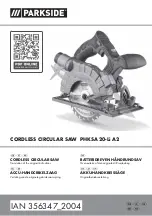
EN
Instruction manual
cutting blade with your hands.
∙
Do not operate the circular saw overhead.
∙
Do not block the movable protective case, do not
allow it to become clogged with sawdust. Should it
be the case, please stop the circular saw and do not
resume its operation until the malfunction is fixed.
∙
Keep hands away from cutting area and the blade.
Keep your second hand on auxiliary handle, or motor
housing.
∙
Never hold piece being cut in your hands or across
your leg. Secure the workpiece to stable platform.
∙
Check guard for proper closing before each use.
If blade get jammed, or when interrupting a cut for any
reason, release the trigger and hold the saw motionless
in the material until the blade comes to a complete
stop. Never attempt to remove the saw from the work
or pull the saw backward while the blade is in motion or
kickback may occur.
UNPACKING
When unpacking, check to make sure that all
components are included. Refer to the drawings on this
manual. If any parts are missing or broken, please call
IVT assistance center.
INITIAL OPERATION
Always use the correct supply voltage: the power supply
voltage must match the information quoted on the tool
identification plate.
CAUSES AND OPERATOR PREVENTION
OF THE KICKBACK
1. Kickback is a sudden reaction to a pinched, bound
or misaligned saw blade, causing the uncontrolled saw
to lift up and out of the work piece toward the operator.
2. When the blade is pinched or bound tightly by
the kerfs closing down, the blade stalls and the motor
reaction drives the unit rapidly back toward the operator.
3. If the blade becomes twisted or misaligned in the
cut, the teeth at the back edge of the blade can dig into
the top surface of the wood, causing the blade to climb
out of the kerfs and jump back toward the operator.
4. Kickback is the result of the tool misuse and/or
incorrect operating procedures or conditions and can be
avoided by taking proper precautions as given below:
∙
Maintain a firm grip with both hands on the saw
and position your body and arms to allow you to resist
kickback forces, which can be controlled by the operator
by taking proper precautions.
∙
When the blade is binding or interrupting a cut
for any reason, release the trigger and hold the saw
motionless in the material until the blade completely
stops.
∙
Never attempt to remove the saw from the work
piece or pull the saw backward while the blade is in
motion or kickback may occur.
∙
Investigate and take corrective action to eliminate
the cause of blade binding.
∙
Wet lumber, green lumber or pressure treated
lumber require special attention during cutting operation,
to prevent kickback.
∙
Avoid cutting nails. Inspect and remove all nails
from lumber before cutting.
∙
When you restart a saw in a work piece, center the
saw blade in the kerfs and check the saw teeth are not
engaged into the material. If the saw blade is binding,
it may walk up or kickback from the work piece as the
saw is restarted.
∙
Support large panels to minimize the risk of blade
pinching and kickback. Large panels tend to sag under
their own weight. Supports must be placed under the
panel on both sides, near the line of cut and near the
edge of the panel.
∙
Do not use dulled or damaged blade.
∙
Unsharpened or improperly set blades produce
narrow kerfs, causing excessive friction, blade binding
and kickback.
∙
Blade depth and bevel adjusting locking knobs must
be tight and secure before cutting. If blade adjustment
shifts while cutting, it may cause binding and kickback.
∙
Using the saw with an excessive cutting depth,
increases loading on the unit and susceptibility to
twisting of the blade in the kerfs. It also increases the
surface area of the blade available for pinching under
conditions of kerfs close down.
∙
Use extra caution when making a «
pocket cut
» into
existing walls or other blind areas. The protruding blade
may cut objects that can cause kickback.
INSTALLATION AND ADJUSTMENT OF
CIRCULAR SAW ELEMENTS
CAUTION! Before carrying out any
works on the power tool it must be
disconnected from the mains.
Replacement of saw blade
1. Put the tool on the end of the electric motor case.
2. While
holding
the
outer
flange
(13)
with
the
pin-spanner
(18),
unscrew
the
saw blade fixing bolt (12) with the help of the spanner
(18).
3. Shift the movable safety guard (11) so that it is
completely inserted into the protective case (4); it shall
13
Summary of Contents for CS-185-RC
Page 6: ...CS 185 RC 7 8 5 12 10 19 4 2 13 1 16 11 9 6 3 15 17 18 14 6 ...
Page 7: ... F2 F3 F1 F4 F5 20 13 12 13 10 12 18 11 17 2 7 ...
Page 8: ... F6 F7 19 8 14 7 6 8 ...
Page 9: ...9 ...
Page 116: ......
Page 117: ......
Page 118: ......
Page 119: ......














































